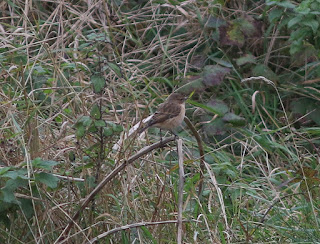Having read about the exciting rarities and rarity events on Scilly over many years, it was all the more satisfying to finally visit the archipelago ...
As the Scillonian prepared to leave Penzance Harbour on 12th October an eclipse male Eider was busily catching crabs nearby ... this is apparently a scarce species in the area but this individual has been regular there recently ...
... as the boat approached St. Mary's a Yellow-billed Cuckoo was reported as showing in the Dump Clump ... it turned out to be a rather elusive individual but eventually perched up in distant sallows for a time before again dropping out of sight ... a Spotted Crake moved through dense vegetation just next to the nearby boardwalk ...
... in the Old Town Churchyard a Red-eyed Vireo performed lively fly-catching manoeuvres ... another bird to allude the camera ...
The next day we visited The Garrison where another elusive bird - a Blue Rock Thrush - finally gave some nice views as it fed at the base of the cliff and on the rocks at the top of the beach ... looking out to sea Shags were a constant presence moving around the coastline ...
... at Newford Duckpond the putative female Green-winged Teal was posing to give the sort of views that Teal rarely give ...
... this was arguably the most interesting bird of the week and seemed to show many pro-Green-winged features...
... the head pattern was notably well-marked
... the anterior wing-bar was distinctly cinnamon at the proximal end
... and the feature which is now considered to be a 'silver bullet', i.e. of the extent of the black stripe on the outermost tertial ( not extending to the feather tip ) fitted also ...
Less contentious was a female Blue-winged Teal on Porth Hellick Pool ... this bird had the reputation of inhabiting the reed-bed most of the time but showed really well on both our visits to the pool ...
... some Greenshanks flew by and on the beach a Kingfisher flashed by the point ...
The following day we crossed to St Martin's to look for a Rose-breasted Grosbeak ... this bird turned out to be another elusive individual ... it was seen at the Bakery, the Quarry and the Cricket Pitch ... it put in brief appearances at each of these locations but remained hidden for long periods of time in between ... the upshot of this was that most people failed to see the bird but learned that chasing it to its last location was a bad strategy ...
... meanwhile a pair of Ravens provided some light relief as they flew by ...
... and three Snow Buntings passed overhead ...
The next day ... and back to Old Town Churchyard where the Red-eyed Vireo gave some better views in the clam of the morning sunshine ... and a juvenile Red-backed Shrike perched obligingly in a nearby hedge ...
... two Pink-footed Geese were an unexpected sight ...
A White-rumped Sandpiper was on Toll's Porth Beach and gave unusually good views as it fed languidly on the deep sea-weed at the top of the beach ...
After our relaxing day on St. Mary's catching up with those aforementioned rarities and scarcities, it was back to St. Martin's with the elusive Rose-breasted Grosbeak and a new strategy in mind ... a prolonged stake-out at the Quarry eventually paid off as the bird perched briefly then flew right across in the direction of the Bakery ... it then gave much better views behind the Bakery as it perched in two separated locations before heading once again into the dense area of bushes ...
... undoubtedly a spectacular looking bird with its bright red under-wing coverts and striking head pattern, delicately rose-tinged breast and blackish wings with white spots ...
Then back on St. Mary's the next day the fields were quiet and the beaches yielded only a few White Wagtails and a scattering of rather attractive Northern Wheatears ...
On our last full day it was back to the Dump Clump for a patient wait where a Red-breasted Flycatcher showed briefly and a Yellow-browed Warbler tantalised in the thick foliage ...
... at Porth Hellick Pool the Blue-winged Teal was again feeding in the open and some Common Snipe lingered nearby ...





































